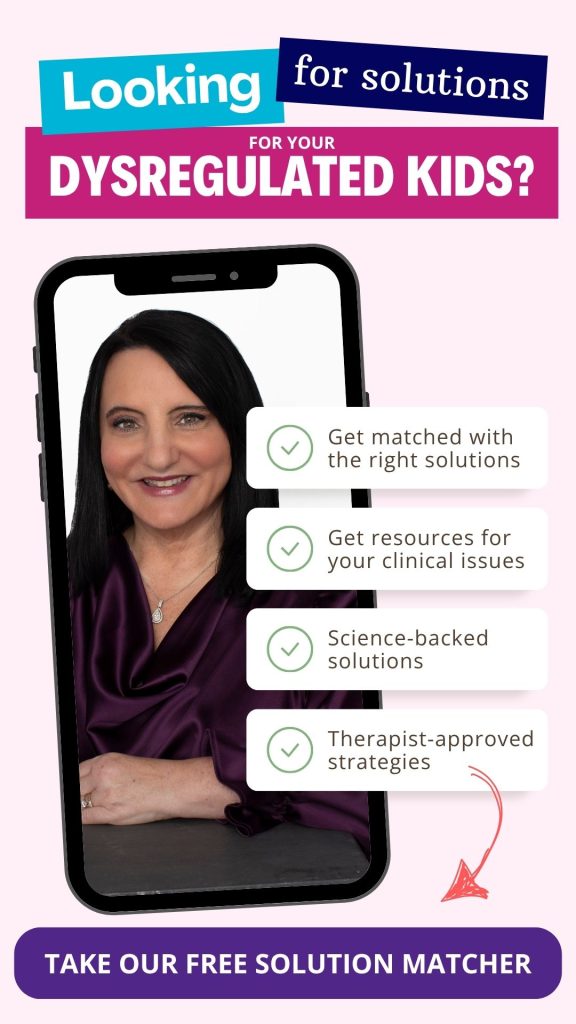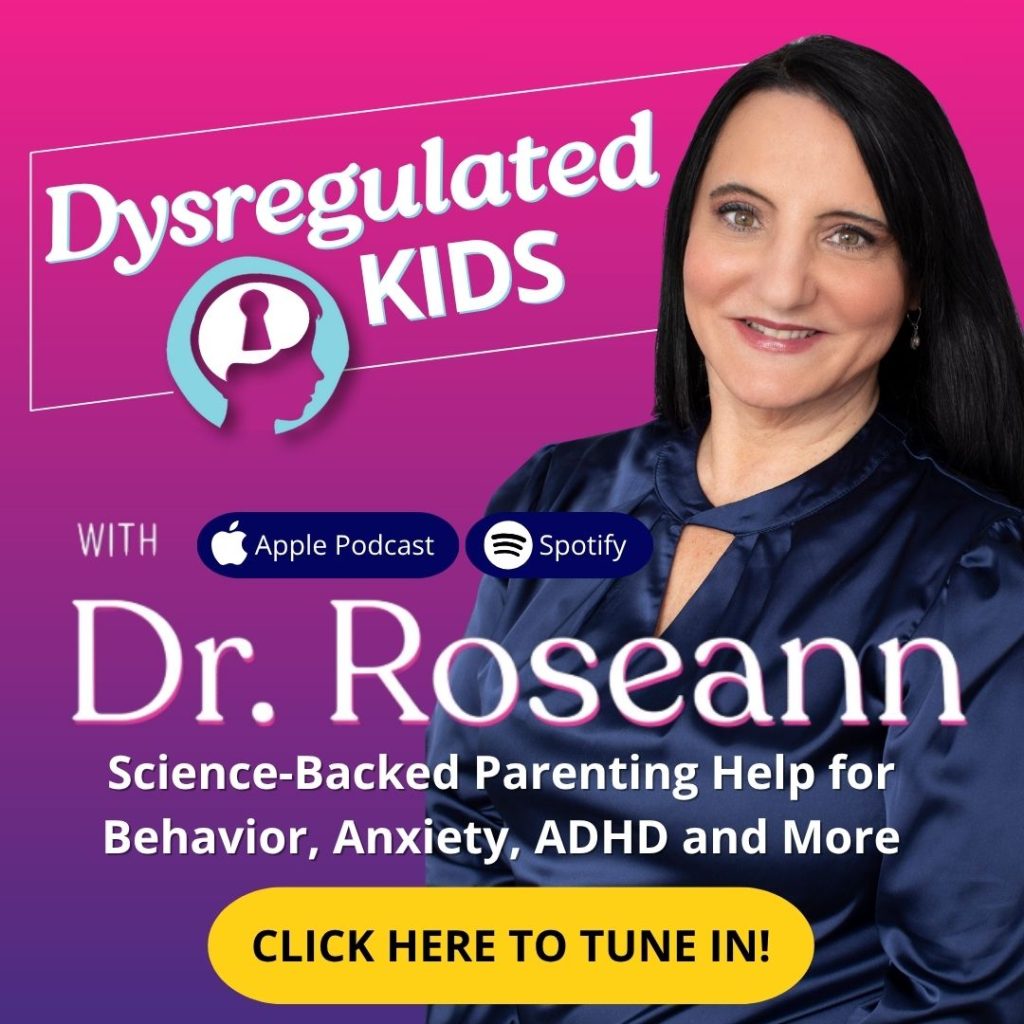Estimated reading time: 8-10 minutes
Ever feel like you’re tiptoeing through your own home, just trying not to set them off? I hear that from parents all the time.
Dysregulation doesn’t look the same for every kid. But that underlying feeling—like your child’s constantly running from a bear only they can see? That’s the thread that connects it all.
And here’s the part most people miss: behavior isn’t the problem. Behavior’s just the smoke—dysregulation’s the fire underneath.
Why Behavior is the Clue, Not the Cause of Dysregulation

When your child flips their lid over screen time—or melts down because their toast touched the eggs—it’s easy to get tunnel vision. The behavior feels loud, chaotic, maybe even on purpose. But what if we paused and asked, “What’s their brain really trying to say?”
Because here’s the thing: dysregulated behavior isn’t a character flaw or defiance. It’s a stress response—like an internal fire alarm going off in a brain that doesn’t feel safe (Porges, 2011; Siegel, 2012).
And when a child’s nervous system is stuck in survival mode, everything feels harder: listening, transitioning, calming down, even just being in their body. These aren’t kids giving you a hard time—they’re having a hard time.
Why do those meltdowns seem so fast and furious?
- Kids don’t yet have the emotional awareness to name what they feel (Gottman, Katz, & Hooven, 1997)
- Self-reflection skills? Still under construction (Zelazo & Cunningham, 2007)
- Language often disappears under stress (Denham et al., 2012)
- And the prefrontal cortex—the brain’s braking system—is still developing (Casey, Tottenham, & Fossella, 2002)
So instead of asking, “How do I stop the behavior?” flip it: “What’s my child’s brain trying to tell me?”
Because once you understand what’s driving the dysregulation, you stop chasing symptoms—and start calming the brain. And that’s where real change begins.
1. Unresolved Trauma and Emotional Memory
Trauma doesn’t always come crashing in—it can creep in quietly over time. And it doesn’t always look like PTSD in kids. Sometimes it shows up as clinginess out of nowhere, angry outbursts over “nothing,” resistance to change, or big reactions to tiny problems. Their nervous system stays on high alert, like a smoke detector that goes off every time you make toast.
Your child might not even remember what caused the stress—especially if it happened before they had words for it. But early experiences, like medical procedures, constant unpredictability, bullying, loss, or even being around adult conflict, can leave a deep imprint on the brain (van der Kolk, 2014).
Once trauma is wired into the nervous system, even something small—a change in tone, a shift in routine—can feel like danger.
What helps:
- Trauma-informed care that sees behavior through a nervous system lens
- Brain-based therapies like neurofeedback to calm overactive alarms
- Co-regulation with a calm, steady adult to help them feel safe
2. Rigid Thinking Patterns and Cognitive Distortions
Dysregulated kids often live in a world of black-and-white thinking.
“If I can’t do it perfectly, I won’t do it at all.”
“If you say no, you must not love me.”
“If plans change, everything is ruined.”
Sound familiar? These aren’t just dramatic moments or attention-seeking. They’re signs of a brain stuck in overdrive.
When the nervous system is stressed, flexible thinking shuts down. The prefrontal cortex—your child’s inner “thinking brain” or CEO—is still developing well into young adulthood (Casey et al., 2008), and it’s especially vulnerable in overwhelmed kids.
That’s why your child can’t just snap out of it. It’s not about willpower—it’s about regulation. And without the right support, those distorted thoughts get stuck on repeat.
Every “no” feels like rejection. Every little change feels like a total derailment.
So what actually helps?
- Using CBT-based strategies to gently reframe rigid thinking
- Practicing coaching language that builds emotional flexibility
- Introducing visual tools to prep the brain for transitions
- Offering somatic supports (like movement or breathwork) that calm the body before you even try to reason
3. Low Frustration Tolerance
Frustration tolerance is your child’s ability to cope when things don’t go their way.
For dysregulated kids, that threshold can be incredibly low—and not because they’re being difficult. It’s because their brain reacts faster and harder to stress… and takes longer to settle down.

You might see:
- Meltdowns over small mistakes
- Avoiding tasks that feel too hard
- Explosive reactions to feedback or redirection
This isn’t drama or manipulation. It’s a nervous system that hasn’t yet built the ability to push through discomfort—and that skill can be developed.
What actually helps:
- Gradual exposure to tolerable stress
- Praising effort, not just results
- Co-regulation—your calm helps shape theirs
4. Negative Self-Talk and Internalized Shame
“I’m stupid.”
“Everyone hates me.”
“I always mess everything up.”
By the time many parents reach out, this is their child’s inner voice—harsh and hopeless. Dysregulation doesn’t just drive behavior—it chips away at self-worth.
Kids with learning or attention challenges often absorb one painful message: You’re too much or not enough. Over time, they believe it.
That shows up as:
- Avoiding hard tasks
- Fearing failure or feedback
- Exploding—or shutting down
But here’s the good news: those beliefs can be rewritten.
Start with:
- Identity-based praise (“You’re a kid who keeps trying”)
- Celebrating effort over outcome
- Connecting in calm, shame-free moments—even after a meltdown
These small shifts help reshape self-perception and build emotional resilience (Crone & Dahl, 2012; Eisenberg et al., 2010).
5. Perceived Rejection and Sensitivity to Social Cues
Many dysregulated kids—especially those with ADHD or anxiety—are wired with something called rejection sensitivity. That means even tiny social cues can feel huge.
They may:
- Take neutral feedback as criticism
- Hear “no” and feel personally attacked
- Spiral after small things, like a friend not waving back
It’s not drama—it’s how a dysregulated brain misreads social information (Bunford et al., 2015).
And when these kids feel misunderstood or rejected, you’ll often see:
- Withdrawal
- Outbursts or aggression
- Total emotional shutdown
What helps:
- Social coaching to build awareness and confidence
- Validating their feelings—without reinforcing false beliefs
- Teaching perspective-taking (but only after they’re calm and regulated)
6. Poor Interoception and Emotional Awareness
Interoception is your internal sense of what’s going on in your body—like when you’re hungry, tired, or anxious.
Many dysregulated kids struggle here. They often:
- Miss early stress signals and don’t realize something’s wrong until they’re already mid-meltdown
- Say “I’m fine” before exploding—because they truly don’t feel the buildup happening
- Respond with “I don’t know” when asked what’s wrong… because they honestly don’t know
When a child can’t identify their feelings or physical cues, it becomes almost impossible for them to regulate (Schauder & Bennetto, 2016).
What helps:
- Body mapping games
- Mindfulness exercises
- Feelings charts
- Teaching the brain-body connection in simple, explicit ways
7. Learned Helplessness from Repeated Failure
If every school day feels like a battle…
If every social interaction ends in hurt…
If every attempt to “be good” still gets them in trouble…
Eventually, a child starts to believe: “Why even try?”
This is called learned helplessness—a psychological state where kids shut down not out of laziness, but because they no longer believe their efforts matter (Maier & Seligman, 2016).
It’s especially common in children with:
- ADHD
- Learning disabilities
- Autism
- Trauma backgrounds
…because they’ve experienced so many moments of failure, rejection, or criticism—often despite giving it everything they had.
What helps:
- Reset the environment with small, achievable wins
- Offer consistent, predictable support
- Help success feel safe again—so the brain learns it’s okay to try
Why Parents Must Shift from Behavior Management to Brain Support
Traditional behavior charts and rewards often miss the mark—because they assume your child’s struggling on purpose.
But here’s the truth: Most dysregulated kids want to do well… they just can’t yet.
When we focus only on behavior, we ignore the psychological, neurological, and emotional terrain beneath it. That’s like treating smoke without putting out the fire.
Your child doesn’t need tougher punishments. They need:
- A regulated nervous system
- A supportive environment
- And tools that actually help their brain build real regulation skills
Let’s Calm the Brain—So Everything Else Can Follow
Feeling like you’re always one meltdown away from losing it yourself? Yep, I’ve been there—and I can tell you, sticker charts won’t touch what’s really going on deep in your child’s brain.
If your home feels more like an emotional war zone than a place of calm, what you need isn’t another consequence—it’s a roadmap for nervous system regulation.
Because what you see as behavior? That’s really dysregulation. And healing begins when we calm the brain first.
Get the Dysregulation Solution and start turning chaos into connection—one step at a time.
FAQs
What is dysregulation disorder?
A dysregulation disorder refers to chronic difficulty managing emotions, behavior, or attention—often tied to how the brain and nervous system process stress. Kids with dysregulation may overreact, shut down, or swing between extremes. It’s not defiance—it’s a brain stuck in survival mode that needs support, not punishment.
What could be causing my child’s big emotions and behavior changes?
Many things can play a role—attachment, self-esteem, trauma, and emotional regulation all shape how a child responds to stress. When their nervous system feels unsafe, behavior becomes reactive, not intentional. Understanding what’s underneath the behavior helps you move away from punishment and toward real, lasting support.
Can my child’s perfectionism be making it harder for them to stay calm?
Absolutely. Kids who feel they have to be perfect—or fear making mistakes—often live with quiet, constant stress. That pressure can eventually spill out as irritability, avoidance, or even meltdowns. The key is to address the perfectionism gently, while also supporting their nervous system so they feel safe trying, learning, and just being themselves.
Citations
Bunford, N., Evans, S. W., & Wymbs, F. (2015). ADHD and Emotion Dysregulation Among Children and Adolescents. Clinical child and family psychology review, 18(3), 185–217. https://doi.org/10.1007/s10567-015-0187-5
Casey, B. J., Jones, R. M., & Hare, T. A. (2008). The adolescent brain. Annals of the New York Academy of Sciences, 1124, 111–126. https://doi.org/10.1196/annals.1440.010
Casey, B. J., Tottenham, N., & Fossella, J. (2002). Clinical, imaging, lesion, and genetic approaches toward a model of cognitive control. Developmental Psychobiology, 40(3), 237–254. https://doi.org/10.1002/dev.10029
Casey, B. J., Tottenham, N., Liston, C., & Durston, S. (2005). Imaging the developing brain: what have we learned about cognitive development?. Trends in cognitive sciences, 9(3), 104–110. https://doi.org/10.1016/j.tics.2005.01.011
Crone, E. A., & Dahl, R. E. (2012). Understanding adolescence as a period of social-affective engagement and goal flexibility. Nature reviews. Neuroscience, 13(9), 636–650. https://doi.org/10.1038/nrn3313
Denham, S. A., Bassett, H. H., Thayer, S. K., Mincic, M. S., Sirotkin, Y. S., & Zinsser, K. (2012). Observing preschoolers’ social-emotional behavior: Structure, foundations, and prediction of early school success. The Journal of Genetic Psychology, 173(3), 246–278. https://doi.org/10.1080/00221325.2011.597457
Eisenberg, N., Spinrad, T. L., & Eggum, N. D. (2010). Emotion-related self-regulation and its relation to children’s maladjustment. Annual review of clinical psychology, 6, 495–525. https://doi.org/10.1146/annurev.clinpsy.121208.131208
Gottman, J. M., Katz, L. F., & Hooven, C. (1997). Meta-emotion: How families communicate emotionally. Lawrence Erlbaum Associates.
Porges, S. W. (2011). The polyvagal theory: Neurophysiological foundations of emotions, attachment, communication, and self-regulation. W. W. Norton & Company.
Schauder, K. B., Mash, L. E., Bryant, L. K., & Cascio, C. J. (2015). Interoceptive ability and body awareness in autism spectrum disorder. Journal of experimental child psychology, 131, 193–200. https://doi.org/10.1016/j.jecp.2014.11.002
Siegel, D. J. (2012). The developing mind: How relationships and the brain interact to shape who we are (2nd ed.). Guilford Press.
van der Kolk, B. A. (2014). The body keeps the score: Brain, mind, and body in the healing of trauma. Viking.
Zelazo, P. D., & Cunningham, W. A. (2007). Executive function: Mechanisms underlying emotion regulation. In J. J. Gross (Ed.), Handbook of Emotion Regulation (pp. 135–158). Guilford Press.
Always remember… “Calm Brain, Happy Family™”
Disclaimer: This article is not intended to give health advice and it is recommended to consult with a physician before beginning any new wellness regime. *The effectiveness of diagnosis and treatment varies by patient and condition. Dr. Roseann Capanna-Hodge, LLC does not guarantee certain results.
Are you looking for SOLUTIONS for your struggling child or teen?
Dr. Roseann and her team are all about science-backed solutions, so you are in the right place!
©Roseann Capanna-Hodge











